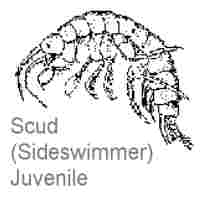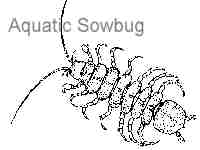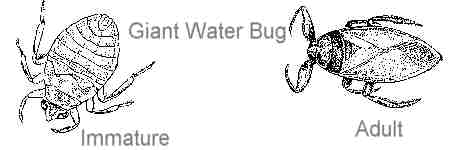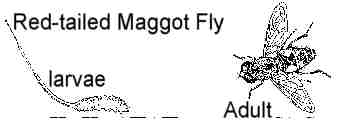WATER BUGS
Assembled from materials produced
by William A. Swenson, Professor
of Biology and UWEX Fishery Specialist UW-Superior

(Daphnia spp., approx. 0.25 - 3.0 mm/0.002 inches)
Water fleas are found in almost all freshwater habitats. They feed
on algae, microsopic one-celled animals (protozoa), bacteria, and organic
detritus (debris). Eaten a lot by small fish, water fleas are an
important element in aquatic food chains. They collect food by moving
their legs to create currents to carry the food to their mouths.
Although there are several species of water fleas, the Daphnia genus are
commonly identified and used in lake studies.
 (Adult (body), 2.5- 3.0 inches; Nymph, 1.0-2.5 inches) Immature
dragonflies tend to be brownish-grey and are often covered with algae.
These characteristics help them blend with their surroundings as they cling
to plants or wait in the mud to catch prey. Nymphs have a diverse diet
including mollusks, insects, worms, and even small fish. Adult dragonflies,
with their excellent eyesight and flight abilities, are also good predators.
Birds and frogs often prey on dragonflies.
(Adult (body), 2.5- 3.0 inches; Nymph, 1.0-2.5 inches) Immature
dragonflies tend to be brownish-grey and are often covered with algae.
These characteristics help them blend with their surroundings as they cling
to plants or wait in the mud to catch prey. Nymphs have a diverse diet
including mollusks, insects, worms, and even small fish. Adult dragonflies,
with their excellent eyesight and flight abilities, are also good predators.
Birds and frogs often prey on dragonflies.

(Adult (body), 1.0-1.8 inches; Nymph, 0.8 inches) Like
dragonflies, the damselfly nymphs tend to blend into their surroundings
and are often covered in algae. Using their strong jaws, the nymphs eat
a variety of foods, ranging from mollusks, insects, crustaceans, worms
and sometimes small fish. Unlike dragonfly nymphs, the damselfly nymphs
has three leaflike gills at the end of its abdomen which it uses to get
oxygen.
 (Larvae, 0.2-0.8 inches) Scuds are small crustaceans that can be found
at the bottom of lakes, ponds, and streams. They typically swim on their
sides through the mud and bottom vegetation. Scuds are considered
scavengers or omnivores, feeding primarily on plant and some animal debris.
Scuds are an important part of the aquatic food web, both as scavengers
(i.e., eating dead or decaying matter) and a source of food for fish which
eat off the bottom or among plants.
(Larvae, 0.2-0.8 inches) Scuds are small crustaceans that can be found
at the bottom of lakes, ponds, and streams. They typically swim on their
sides through the mud and bottom vegetation. Scuds are considered
scavengers or omnivores, feeding primarily on plant and some animal debris.
Scuds are an important part of the aquatic food web, both as scavengers
(i.e., eating dead or decaying matter) and a source of food for fish which
eat off the bottom or among plants.
 (Adult, 0.5 inches; Larvae, 0.6-1.5 inches) Caddisfly larvae are soft-bodied
– some species are free-living while others make a case out of plant matter,
sand, pebbles, twigs, grass, etc. Different caddisfly larvae species
have different feeding habits. Some eat mostly moss, algae, and dead leaves
but some are also known to eat small dead animals. Others eat small living
animals, insects, and plants. Adult caddisflies look like moths, are active
at night, and have long antennae and large wings. They adults eat very
little before their mating ritual occurs.
(Adult, 0.5 inches; Larvae, 0.6-1.5 inches) Caddisfly larvae are soft-bodied
– some species are free-living while others make a case out of plant matter,
sand, pebbles, twigs, grass, etc. Different caddisfly larvae species
have different feeding habits. Some eat mostly moss, algae, and dead leaves
but some are also known to eat small dead animals. Others eat small living
animals, insects, and plants. Adult caddisflies look like moths, are active
at night, and have long antennae and large wings. They adults eat very
little before their mating ritual occurs.
 (Approx. 0.8-1.0 inches) Aquatic sow bugs are most often found in streams
but are sometimes seen in ponds and lakes. Although they aren't good
swimmers like the scuds, aquatic owbugs eat dead and decaying matter like
scuds do.
(Approx. 0.8-1.0 inches) Aquatic sow bugs are most often found in streams
but are sometimes seen in ponds and lakes. Although they aren't good
swimmers like the scuds, aquatic owbugs eat dead and decaying matter like
scuds do.

Adult, 0.9 inches; Larvae, 1.0 inches) Horsefly larvae are stout and
look like worms with tapered ends. The larvae, which live in the
water, feed on snails, worms, and other small animals.

(Adult, 1.0-2.5 inches; Larvae, 0.8-1.0 inches) Mayfly larvae typically
feed on live or decaying plants, including leaves and algae from plant
stems. While mayfly nymphs live for about a year, the adults lives
three days or less – just enough time to mate and lay eggs. The nymphs
have 7 pairs of gills along the abdomen and they have 3 (sometimes 2) feathery
tails. Adult mayflies hve four wings which are almost transparent.

(Adult, up to 3 inches) Giant Water Bugs are the largest of true bugs
and can eat an animal fifty times bigger than itself! Large adult
Water Bugs will ambush other insects, tadpoles, crustaceans, and even frogs.
They kill their prey with poison secreted when they bite.
 (Adult, 0.2-0.3 inches; Larvae, 0.2-0.5 inches) Mosquitoes are often found
in ponds, swamps, marshes, and lakes. Mosquito larvae often rest
on the water surface with their breathing tubes open to the air.
Larvae eat microscopic animals, algae, and debris, using mouth brushes
to filter their food. As adults, only females bite to get a meal of blood
while males usually eat nectar and ripe fruit.
(Adult, 0.2-0.3 inches; Larvae, 0.2-0.5 inches) Mosquitoes are often found
in ponds, swamps, marshes, and lakes. Mosquito larvae often rest
on the water surface with their breathing tubes open to the air.
Larvae eat microscopic animals, algae, and debris, using mouth brushes
to filter their food. As adults, only females bite to get a meal of blood
while males usually eat nectar and ripe fruit.

(Adult, approx. 0.8 inches) Water Strider (Pond Skater) are thin, brownish-black
bugs with long legs which spend most of their lives watching for and eating
dead or drowning insects which get trapped on the water surface.

(Adult, approx. 1.0 inches) Water Boatman are slender insects with
long hind legs suited for swimming. The Water Boatman will hold onto
a plant stem or other object to stay under water. It gets air from the
surface which usually surrounds the bug in a silvery bubble. Water
Boatmen eat plant and animal remains sucked from the bottom ooze.
They will also eat algae and plant fluids.
 (Adult, 0.5 inches, larvae, approx. 0.8-1.0 inches) Whirligig Beetle larvae
crawl along the bottom of plants. Adults are shiny, bluish-black
beetles that live on the water surface and are known for their antics as
they skim the water's surface and dive underwater. The adults sometimes
protect themselves by emitting a foul odor which fends off predators.
They also have eyes split so they can see above and below the water surface.
The larvae are carnivores while the adults eat dead plants and animals.
(Adult, 0.5 inches, larvae, approx. 0.8-1.0 inches) Whirligig Beetle larvae
crawl along the bottom of plants. Adults are shiny, bluish-black
beetles that live on the water surface and are known for their antics as
they skim the water's surface and dive underwater. The adults sometimes
protect themselves by emitting a foul odor which fends off predators.
They also have eyes split so they can see above and below the water surface.
The larvae are carnivores while the adults eat dead plants and animals.
 (Adult, 0.2 inches; larvae inches) Most midge larva feed on smaller
larvae, microorganisms, and decaying matter. Midges are an important
link in food webs, providing nourishment for many fish. The larvae of true
midges usually have a red color to them and are called bloodworms; they
will eat fragments of plants floating on the water and small clam shrimp.
Most midges are harmless to humans but the "no-see-ums" are known for their
biting. Depending on the species, midges can be predators, herbivores,
or omnivores. They tend to be more tolerant of pollution.
(Adult, 0.2 inches; larvae inches) Most midge larva feed on smaller
larvae, microorganisms, and decaying matter. Midges are an important
link in food webs, providing nourishment for many fish. The larvae of true
midges usually have a red color to them and are called bloodworms; they
will eat fragments of plants floating on the water and small clam shrimp.
Most midges are harmless to humans but the "no-see-ums" are known for their
biting. Depending on the species, midges can be predators, herbivores,
or omnivores. They tend to be more tolerant of pollution.
 (Approx. 1.5 inches) Red-tailed Maggot (Drone Fly Larvae) The larvae of
the drone flies (or hover flies) are called red-tailed maggots and tend
to be tolerant of polluted waters. Red-tailed maggots usually live
at the bottom of shallow waters. They have a long tail that draws
oxygen from the air.
(Approx. 1.5 inches) Red-tailed Maggot (Drone Fly Larvae) The larvae of
the drone flies (or hover flies) are called red-tailed maggots and tend
to be tolerant of polluted waters. Red-tailed maggots usually live
at the bottom of shallow waters. They have a long tail that draws
oxygen from the air.
 (Adult, 2.7 inches; Larvae, up to 3.0 inches) Hellgrammite larvae can live
2-3 years in the water and are a preferred bait for fishing. The
larvae will later emerge on land as adults that only live a few days. Hellgrammites
eat other living things, mostly insects, using its large jaws. Hellgrammites
absorb oxygen through gills on the sides of their abdomen or through the
surface of their bodies. An adult male dobsonfly is quite a sight with
its 1-inch curved mandibles.
(Adult, 2.7 inches; Larvae, up to 3.0 inches) Hellgrammite larvae can live
2-3 years in the water and are a preferred bait for fishing. The
larvae will later emerge on land as adults that only live a few days. Hellgrammites
eat other living things, mostly insects, using its large jaws. Hellgrammites
absorb oxygen through gills on the sides of their abdomen or through the
surface of their bodies. An adult male dobsonfly is quite a sight with
its 1-inch curved mandibles.
 (Adult size, 1 inch; larval size, about 1.1 inch) Predaceous Diving Beetle
larvae are long, thin and have a small head. The adults are shiny,
brownish-black in color and are good fliers. Both the adults and larvae
are known to eat small fish, tadpoles, other insects and small animals.
(Adult size, 1 inch; larval size, about 1.1 inch) Predaceous Diving Beetle
larvae are long, thin and have a small head. The adults are shiny,
brownish-black in color and are good fliers. Both the adults and larvae
are known to eat small fish, tadpoles, other insects and small animals.
 (Adult, approx. 2.5 inches) Although Water Scorpions walk slowly,
they can ambush prey (mostly insects) with a quick strike of their forelegs.
They live underwater but get air using a clever "snorkel." This breathing
tube is formed when water scorpions hold their two rear appendages together
and push them through the water surface.
(Adult, approx. 2.5 inches) Although Water Scorpions walk slowly,
they can ambush prey (mostly insects) with a quick strike of their forelegs.
They live underwater but get air using a clever "snorkel." This breathing
tube is formed when water scorpions hold their two rear appendages together
and push them through the water surface.

 (Adult (body), 2.5- 3.0 inches; Nymph, 1.0-2.5 inches) Immature
dragonflies tend to be brownish-grey and are often covered with algae.
These characteristics help them blend with their surroundings as they cling
to plants or wait in the mud to catch prey. Nymphs have a diverse diet
including mollusks, insects, worms, and even small fish. Adult dragonflies,
with their excellent eyesight and flight abilities, are also good predators.
Birds and frogs often prey on dragonflies.
(Adult (body), 2.5- 3.0 inches; Nymph, 1.0-2.5 inches) Immature
dragonflies tend to be brownish-grey and are often covered with algae.
These characteristics help them blend with their surroundings as they cling
to plants or wait in the mud to catch prey. Nymphs have a diverse diet
including mollusks, insects, worms, and even small fish. Adult dragonflies,
with their excellent eyesight and flight abilities, are also good predators.
Birds and frogs often prey on dragonflies.

 (Larvae, 0.2-0.8 inches) Scuds are small crustaceans that can be found
at the bottom of lakes, ponds, and streams. They typically swim on their
sides through the mud and bottom vegetation. Scuds are considered
scavengers or omnivores, feeding primarily on plant and some animal debris.
Scuds are an important part of the aquatic food web, both as scavengers
(i.e., eating dead or decaying matter) and a source of food for fish which
eat off the bottom or among plants.
(Larvae, 0.2-0.8 inches) Scuds are small crustaceans that can be found
at the bottom of lakes, ponds, and streams. They typically swim on their
sides through the mud and bottom vegetation. Scuds are considered
scavengers or omnivores, feeding primarily on plant and some animal debris.
Scuds are an important part of the aquatic food web, both as scavengers
(i.e., eating dead or decaying matter) and a source of food for fish which
eat off the bottom or among plants.
 (Adult, 0.5 inches; Larvae, 0.6-1.5 inches) Caddisfly larvae are soft-bodied
– some species are free-living while others make a case out of plant matter,
sand, pebbles, twigs, grass, etc. Different caddisfly larvae species
have different feeding habits. Some eat mostly moss, algae, and dead leaves
but some are also known to eat small dead animals. Others eat small living
animals, insects, and plants. Adult caddisflies look like moths, are active
at night, and have long antennae and large wings. They adults eat very
little before their mating ritual occurs.
(Adult, 0.5 inches; Larvae, 0.6-1.5 inches) Caddisfly larvae are soft-bodied
– some species are free-living while others make a case out of plant matter,
sand, pebbles, twigs, grass, etc. Different caddisfly larvae species
have different feeding habits. Some eat mostly moss, algae, and dead leaves
but some are also known to eat small dead animals. Others eat small living
animals, insects, and plants. Adult caddisflies look like moths, are active
at night, and have long antennae and large wings. They adults eat very
little before their mating ritual occurs.
 (Approx. 0.8-1.0 inches) Aquatic sow bugs are most often found in streams
but are sometimes seen in ponds and lakes. Although they aren't good
swimmers like the scuds, aquatic owbugs eat dead and decaying matter like
scuds do.
(Approx. 0.8-1.0 inches) Aquatic sow bugs are most often found in streams
but are sometimes seen in ponds and lakes. Although they aren't good
swimmers like the scuds, aquatic owbugs eat dead and decaying matter like
scuds do.



 (Adult, 0.2-0.3 inches; Larvae, 0.2-0.5 inches) Mosquitoes are often found
in ponds, swamps, marshes, and lakes. Mosquito larvae often rest
on the water surface with their breathing tubes open to the air.
Larvae eat microscopic animals, algae, and debris, using mouth brushes
to filter their food. As adults, only females bite to get a meal of blood
while males usually eat nectar and ripe fruit.
(Adult, 0.2-0.3 inches; Larvae, 0.2-0.5 inches) Mosquitoes are often found
in ponds, swamps, marshes, and lakes. Mosquito larvae often rest
on the water surface with their breathing tubes open to the air.
Larvae eat microscopic animals, algae, and debris, using mouth brushes
to filter their food. As adults, only females bite to get a meal of blood
while males usually eat nectar and ripe fruit.


 (Adult, 0.5 inches, larvae, approx. 0.8-1.0 inches) Whirligig Beetle larvae
crawl along the bottom of plants. Adults are shiny, bluish-black
beetles that live on the water surface and are known for their antics as
they skim the water's surface and dive underwater. The adults sometimes
protect themselves by emitting a foul odor which fends off predators.
They also have eyes split so they can see above and below the water surface.
The larvae are carnivores while the adults eat dead plants and animals.
(Adult, 0.5 inches, larvae, approx. 0.8-1.0 inches) Whirligig Beetle larvae
crawl along the bottom of plants. Adults are shiny, bluish-black
beetles that live on the water surface and are known for their antics as
they skim the water's surface and dive underwater. The adults sometimes
protect themselves by emitting a foul odor which fends off predators.
They also have eyes split so they can see above and below the water surface.
The larvae are carnivores while the adults eat dead plants and animals.
 (Adult, 0.2 inches; larvae inches) Most midge larva feed on smaller
larvae, microorganisms, and decaying matter. Midges are an important
link in food webs, providing nourishment for many fish. The larvae of true
midges usually have a red color to them and are called bloodworms; they
will eat fragments of plants floating on the water and small clam shrimp.
Most midges are harmless to humans but the "no-see-ums" are known for their
biting. Depending on the species, midges can be predators, herbivores,
or omnivores. They tend to be more tolerant of pollution.
(Adult, 0.2 inches; larvae inches) Most midge larva feed on smaller
larvae, microorganisms, and decaying matter. Midges are an important
link in food webs, providing nourishment for many fish. The larvae of true
midges usually have a red color to them and are called bloodworms; they
will eat fragments of plants floating on the water and small clam shrimp.
Most midges are harmless to humans but the "no-see-ums" are known for their
biting. Depending on the species, midges can be predators, herbivores,
or omnivores. They tend to be more tolerant of pollution.
 (Approx. 1.5 inches) Red-tailed Maggot (Drone Fly Larvae) The larvae of
the drone flies (or hover flies) are called red-tailed maggots and tend
to be tolerant of polluted waters. Red-tailed maggots usually live
at the bottom of shallow waters. They have a long tail that draws
oxygen from the air.
(Approx. 1.5 inches) Red-tailed Maggot (Drone Fly Larvae) The larvae of
the drone flies (or hover flies) are called red-tailed maggots and tend
to be tolerant of polluted waters. Red-tailed maggots usually live
at the bottom of shallow waters. They have a long tail that draws
oxygen from the air.
 (Adult, 2.7 inches; Larvae, up to 3.0 inches) Hellgrammite larvae can live
2-3 years in the water and are a preferred bait for fishing. The
larvae will later emerge on land as adults that only live a few days. Hellgrammites
eat other living things, mostly insects, using its large jaws. Hellgrammites
absorb oxygen through gills on the sides of their abdomen or through the
surface of their bodies. An adult male dobsonfly is quite a sight with
its 1-inch curved mandibles.
(Adult, 2.7 inches; Larvae, up to 3.0 inches) Hellgrammite larvae can live
2-3 years in the water and are a preferred bait for fishing. The
larvae will later emerge on land as adults that only live a few days. Hellgrammites
eat other living things, mostly insects, using its large jaws. Hellgrammites
absorb oxygen through gills on the sides of their abdomen or through the
surface of their bodies. An adult male dobsonfly is quite a sight with
its 1-inch curved mandibles.
 (Adult size, 1 inch; larval size, about 1.1 inch) Predaceous Diving Beetle
larvae are long, thin and have a small head. The adults are shiny,
brownish-black in color and are good fliers. Both the adults and larvae
are known to eat small fish, tadpoles, other insects and small animals.
(Adult size, 1 inch; larval size, about 1.1 inch) Predaceous Diving Beetle
larvae are long, thin and have a small head. The adults are shiny,
brownish-black in color and are good fliers. Both the adults and larvae
are known to eat small fish, tadpoles, other insects and small animals.
 (Adult, approx. 2.5 inches) Although Water Scorpions walk slowly,
they can ambush prey (mostly insects) with a quick strike of their forelegs.
They live underwater but get air using a clever "snorkel." This breathing
tube is formed when water scorpions hold their two rear appendages together
and push them through the water surface.
(Adult, approx. 2.5 inches) Although Water Scorpions walk slowly,
they can ambush prey (mostly insects) with a quick strike of their forelegs.
They live underwater but get air using a clever "snorkel." This breathing
tube is formed when water scorpions hold their two rear appendages together
and push them through the water surface.